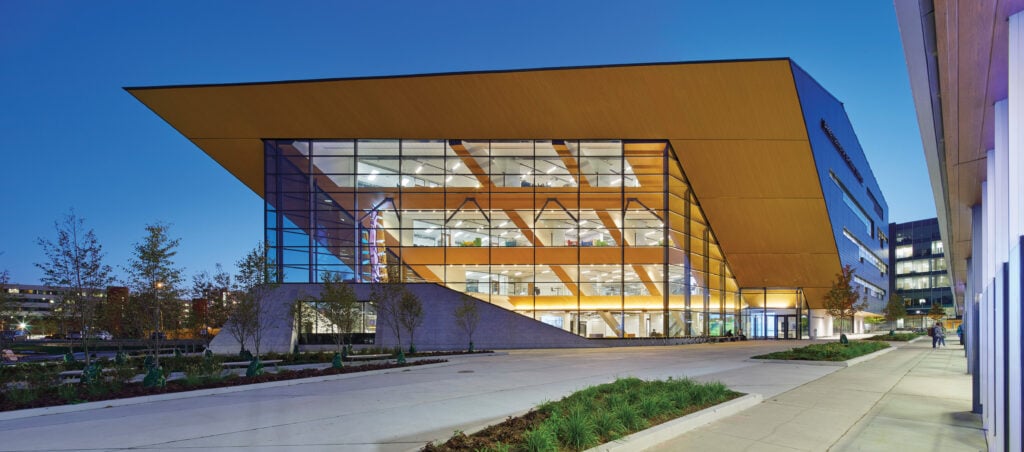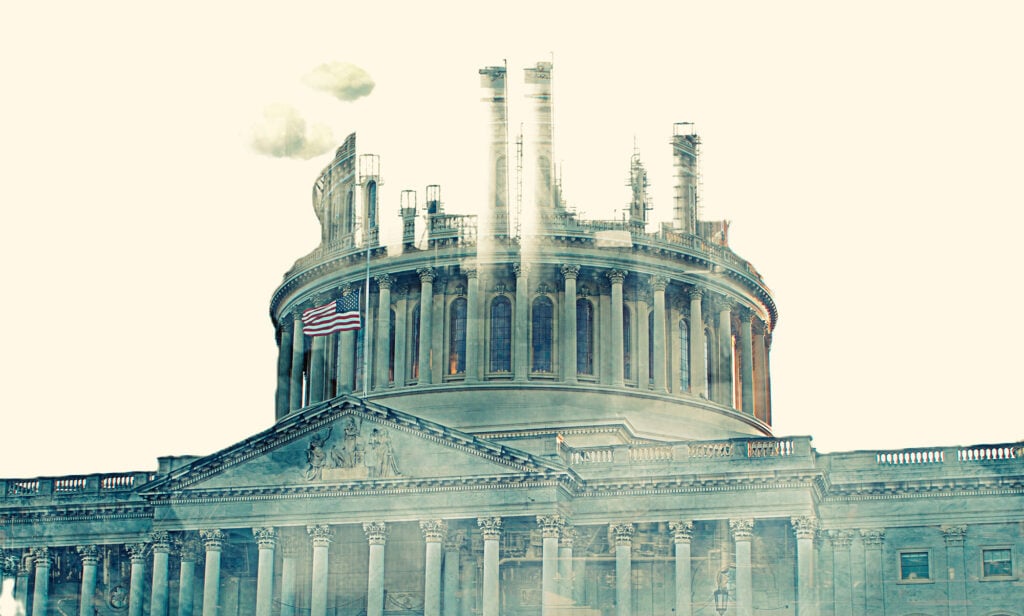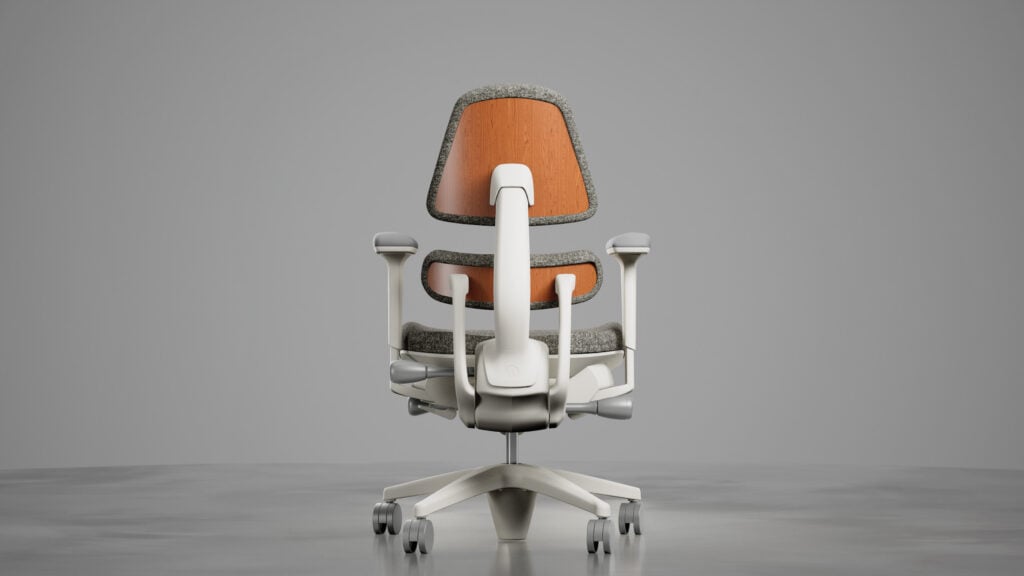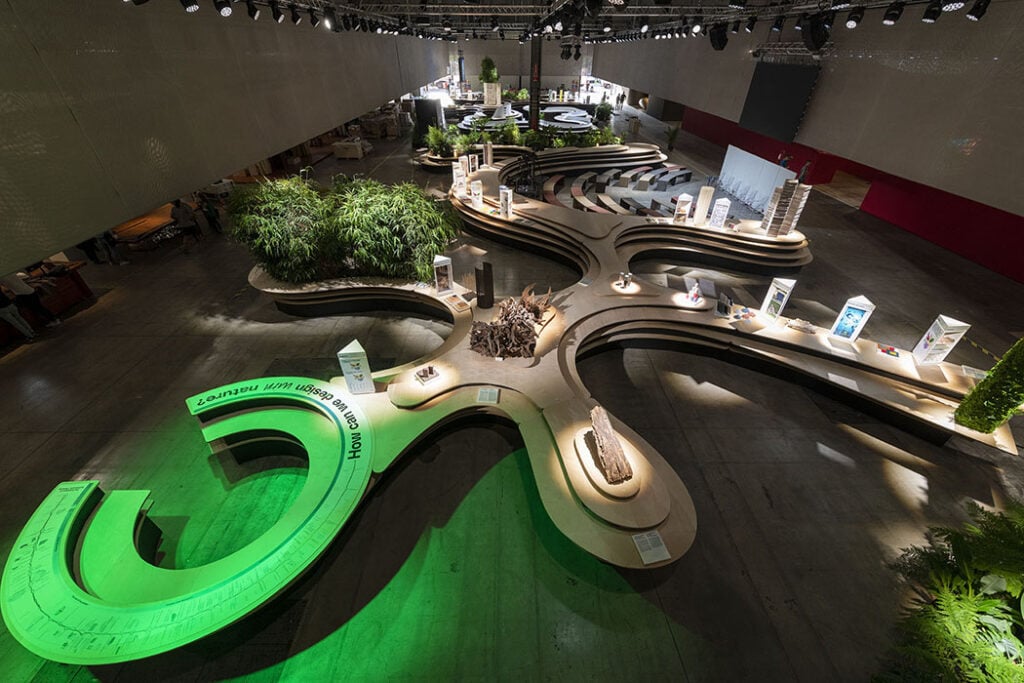
June 29, 2022
Mario Cucinella Broadens Sustainable Horizons at Salone
The question is, what does sustainability mean in an installation?
Mario Cucinella
Sam Lubell: Every year Salone presents installations by high-caliber architects—it’s one of my favorite parts of the show. This year you’ve worked on Design with Nature, an installation that’s a place for gathering in Pavilion 15. It’s an interesting design itself, but there’s a much deeper message than just, “Okay, we’re going to gather here and look at cool things.” There’s a very deeply embedded sustainable agenda there.
Mario Cucinella: Salone asked me to do an exhibition about sustainability; highlighting its policies, partnerships, and emphasis on sustainable practices and materials. The question is, what does sustainability mean in an installation?
My first reaction was that there are three main issues that I think are important to show. One is about our current ecological transition. The many new materials connected with nature, deriving from fruits, vegetables, trees, leaves, fish, and so on. It was an incredible experience discovering these new materials; these new companies who are starting to work this way. There’s a whole new world of materials. The installation contains 25 biomaterials. From the skins of oranges we have fabrics; from the skins of fish or from roots we have panels. It’s become part of the industry.
Another theme is the city as a mine. We all talk about regeneration, reuse, and rebuilding. We want to show that the city already contains the materials we need. Concrete, steel, aluminum, glass, plastics—everything. So maybe if we can use the materials of the city to make new buildings, that would be another way to see the city not as a problem but as an opportunity?
The final theme is about how, after COVID, so much has changed in the way people look at living; how they’re using their apartment, they’re smart working. People are raising questions like, “Maybe if I work at home, I have more time for myself and my kids,” or “I can manage to work and decide my time, not to go every morning from home office,” and the impact of traffic is huge.
So we’ve made this installation to provoke questions and hopefully prompt solutions. It contains a restaurant, a bar, and a place for reading books—we’ve prepared a list of 80 books related to material experiments, green philosophy, and botanics. Then there will be an exhibition of new materials. I think the message in the end is that we can only win the battle of sustainability if every one of us does something. Small things. And if we work together, maybe it’s much easier. It’s not about one person, it’s about all of us. So you’ll be at Salone and you can sit on a bench and drink something nice, and there’ll be a lot of bio-based products and reading materials in front of you. There will be three chefs cooking only natural foods. So you can discover how the future will be more healthy. I think it’s a very positive message.
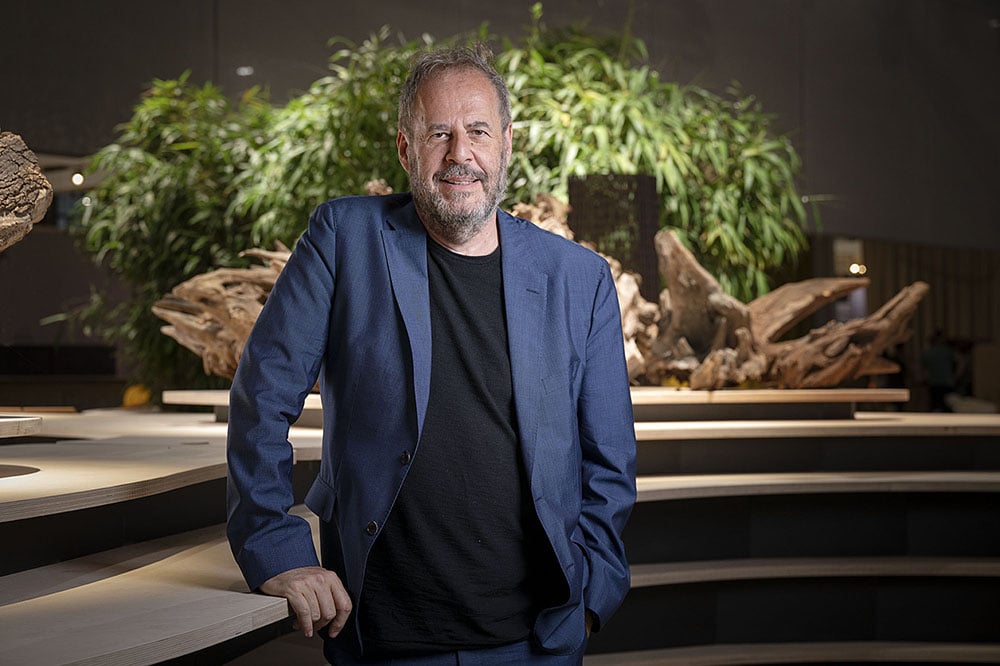
SL: I love that there are so many components to the message. It’s not just a one note theme. Also, just in the way it is designed; obviously it’s very natural. It sort of looks like it’s eroded. It looks like it’s part of an ecosystem itself.
MC: The idea was to make something that seemed very natural, designed with curves and bays, where you could gather around a circle, or in little nooks. We wanted several different situations. It’s based on natural systems, like roots. It’s not so rational. It’s very curvy, with different layers, like stratification; like a stone’s layers. We also illuminated it with a rainbow of colors so it would be a joyful thing.
There’s a little forest, and there’s bamboo seating that you can sit for a few minutes inside. The little bubble-like forest is all around you—for a few minutes, you forget you’re at Salone and you’re in the middle of nature. You can sit together with others, or you can have a moment of doing something alone. It’s curvy and it’s all around you.
SL: I love what you mentioned just before, about ecological transition. It’s so imbedded in our brains, what things should be built of. And you’re really experimenting in a lot of your work with new natural materials. Can you pull out one or two examples of where you used one of these unusual biomaterials in this installation or elsewhere in your work?
MC: For one, we created a sort of skyscraper with old newspapers. They make amazing, beautiful panels. They can be a fantastic material for furniture. They make tables, countertops, and so on. We’ve also employed fish scales—which normally get thrown away—to make beautiful compressed panels. We have a bench made of hemp, which is very solid. Before the Industrial Revolution, most materials came only from natural resources. We can do this again, but with more scientific and technological knowledge. I think there’s a lot of creativity that comes along with the idea of making materials no longer dependent on the oil industry. I think it is a message of hope. There are many, many problems, but I feel humanity is always trying to find a way to save the planet.
SL: A way to fix our mistakes.
MC: Yes, and I think there’s no option. It’s not nostalgic or romantic. We need to start building with less concrete, less steel, less plastic; with a new generation of materials. It’s no longer something that is nice to do. We must do it and that’s it.
SL: That’s a good point. We’re not doing it out of the goodness of our hearts, we’re doing it because it’s what we have to do. I think what your installation has excited you about all these possibilities. And I think that’s got to be what the goal is for people coming to Milan. It’s opening their eyes.
MC: Yes, and once Salone closes, the installation itself will be recycled. It’ll be used as part of a school or a public space. We’ve talked about bringing a piece to the new technology center in Bologna. The new generation are quite keen to know about this topic. I thought if we could bring it to different schools around the region, they can really see and experience these materials and techniques.
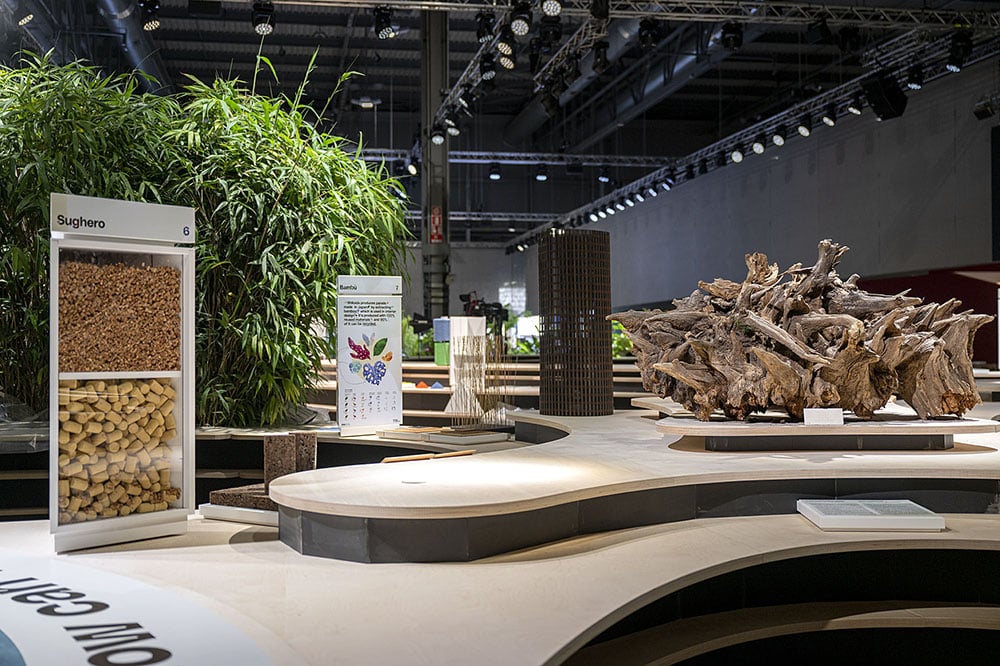
SL: That makes a lot of sense. And it obviously it dovetails well with Salone’s own goals. I know the fair has made a real priority in terms of its guidelines regarding recycled, renewable, and healthy materials. Can you talk a little bit about that?
MC: First the organizers have decided to only use the ground floor of the Fiera; to consolidate and minimize the amount of structures produced. You can imagine how much waste is produced from the installations. All the panels and plastics. Our installation also demonstrates how you can improve recycling. When you’re recycling plastic, there’s always something left over. There’s a company in Tuscany that takes everything left and prints pieces from them. All the tools that you can see in our exhibition are made with this leftover plastic. And Salone, when they saw this, they said, ‘Oh wow, we have so much plastic at the end of the exhibition.’ So they contacted the same company to take their waste and make structures like benches and tables. I think these things work, because if you show what’s possible, people do it. Salone has often been about showing off. Everybody wants to be the best and the biggest. I think we’re heading toward something more subtle; less about glamor and extravaganza.
SL: I think so too, and architecture, to some extent is starting to reflect that it’s not as much about showpiece architecture. You bring up really a good point, which is that the exhibition industry is notorious as one of the most wasteful industries there is. But another industry that’s not so great is the furniture industry, which is what’s being shown off here. I think the other question is yes, the show can be more sustainable, but how do we make it so that these companies that are churning out products—and obviously they’re starting to recycle things, they’re starting to use things like biomaterials—how do you make that the norm? It doesn’t seem, at this point, financially feasible to make everything this way. You can make some very expensive products, but how do you shift the whole battleship in the other direction?
MC: Our plan in Europe is to cut greenhouse gases in half by 2030, and to achieve carbon neutrality by 2050, and I think you need time for the industry to adapt itself to a new way of doing things. There is a knowledge that this is shifting, but you’re not going to do it in a year. If your company is successful in making something, then you ask “why would I want to change? Why do I need to change?” Pavilion 15 at Salone is all about sustainability. These are companies that already engaged in this, using the right materials in their products, using recycled materials for their installations. It’s a very special pavilion. Everybody wants to be there because they can say, “We want to show that we’re sustainable.” Salone is very particular about its selection, and that’s a sign that the pavilion is a success.
Maybe other companies will decide that the markets are asking for something new. I think it goes back to the customer. If all of us start to say, “No, I want a sofa where the fabrics come from nature; and maybe it’s a little bit more expensive, but I know there’s an ethic behind. There’s a value, an environmental value.” I think we can change the market. It’s like food. People have changed the market because they’ve asked for safer and healthier food, and companies have been obliged to do that.
SL: Right, the market is very powerful, and I think someday there won’t be a Pavilion 15 that’s green. Every pavilion will be like that. Another field that is notoriously wasteful, and despite efforts, still not particularly sustainable, is your field, architecture. Your other field, I should say. Your firm is working on a number of projects to push sustainability. I know I’ve talked to you before about your TECLA project, where you are using automated construction and biomaterials.
MC: The construction industry will not be easy to change, because buildings of course need to stand up and have robust structures. But the question arises, “What’d would be the answer if you wanted to meet Europe’s ambitious sustainability goals?” Our answer was TECLA, which stands for technology and clay. We have designed and built houses on various sites with local natural materials like corn husks through automation. You don’t have to transport any material, don’t use any mechanical equipment, and build on site. Of course, it’s more experimental than something you can replicate everywhere, but this is an answer.
I think the industry is undertaking a sort of transition; maybe not tomorrow, but it’s starting. Sustainable finishes. Recycled tiles and aluminum. LED lights. Again, there’s no other option on the table. If you don’t start building like this, you will never get to 2030 or 2050 because you need more than 10 years to transform this industry. For me, it’s always a combination, like if you reduce the pollution and noise in a city you might be more likely to open your windows. And if air the is not polluted, maybe you can ventilate your building. And if you ventilate the building, maybe you don’t need air conditioning for all the year. And if your buildings are well-insulated or very high performance, you demand less energy, and maybe that energy, you can power it with renewable energy. So it’s all part of a chain. It’s not about one material, it’s about a global strategy. This idea of sustainability is an ecosystem of solutions.
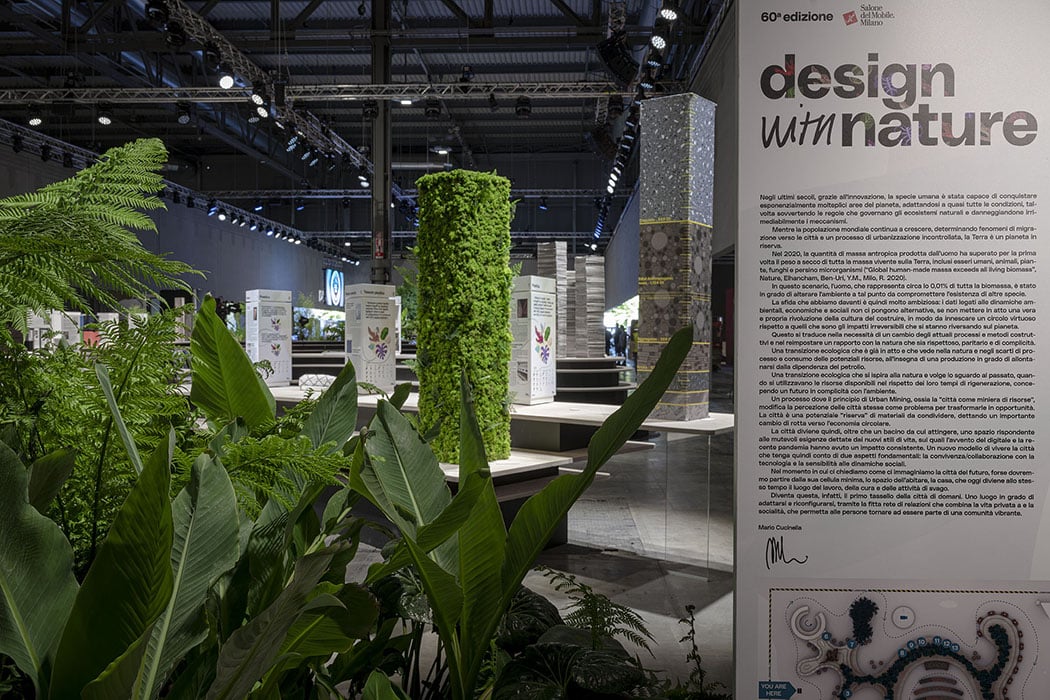
SL: With furniture and architecture, the way our markets are designed is we want to make more and more and more, but how do we say, “You know what? We don’t need to revamp that office after three years,” or “We don’t need to build a new building when we have an old that we can revamp, or we can rehabilitate.” How do you reform the markets to say, “We don’t need to make maybe as much money?” That’s a tough one.
MC: I don’t think business is a bad thing. It benefits many people. But when business comes first, all buildings start to look the same. Because the idea is always the same: how much profit can I make per square meter? Then we no longer care about the impact on people and the environment. So I hope this will change a little bit because of climate change. You realize by the numbers that our current trajectory is absolutely unsustainable. We can’t sustain a place where nature is completely out of the game. So I think it’s a very exciting moment, because we’re starting to rethink after maybe 50 years of booming—creating so much wealth around the world. There must be an equilibrium now. The richness of the West is so great. And still, we have so many poor, so there’s something wrong. Something isn’t working.
SL: Yes, as you said, none of it is sustainable. And eventually, like you said in terms of the ecology, but also in terms of, frankly, our social systems, none of this is sustainable. And it’s coming back to haunt us in every way. But it also goes back to what you were saying: whether we like it or not, we’re going to shift to this new model. We have to. And it’s starting to get reflected, I think, in architecture and in the design of things. I always think in architecture, certain styles really reflect what are the priorities of that age, and I think we’re going to start eventually having designs that show a shift in priorities towards the better. We have to. I think it’s going to be interesting to see how that impacts design itself.
MC: From 1950 to around 2000 — this kind of a period of happiness and prosperity made us think the world had no limits. There was a lot of hope. I think it was a good, but misguided, sentiment; we’re living in a period of time with this idea that resources are unlimited and that we can make everything we want. I think it was really positive. Today, it’s not like this. And that’s expressed in buildings too. Many buildings of the 1980’s and 90’s express this euphoria and this idea of wow, the world will be endless. Now, I think we realize that it’s not like this anymore, so the question is, what will the aesthetic of sustainability be? Euphoric? Or maybe sober? I don’t know. I think we are in the process of understanding. We’re still in that past world with our culture, but we’re looking for another way. We’re looking for a future that will be different, so I think we are a little bit confused.
SL: I agree. I think these are interesting times, because we don’t know what is taking place; it’s still being determined. We won’t know for another probably 20 years, I’d say, what’s going on. Well, Mario, this is fascinating. We’ll have to do it again another time, do some more discussions. And I really, really appreciate you chatting. It’s really an honor and a pleasure to speak with you.
MC: Thank you very much.
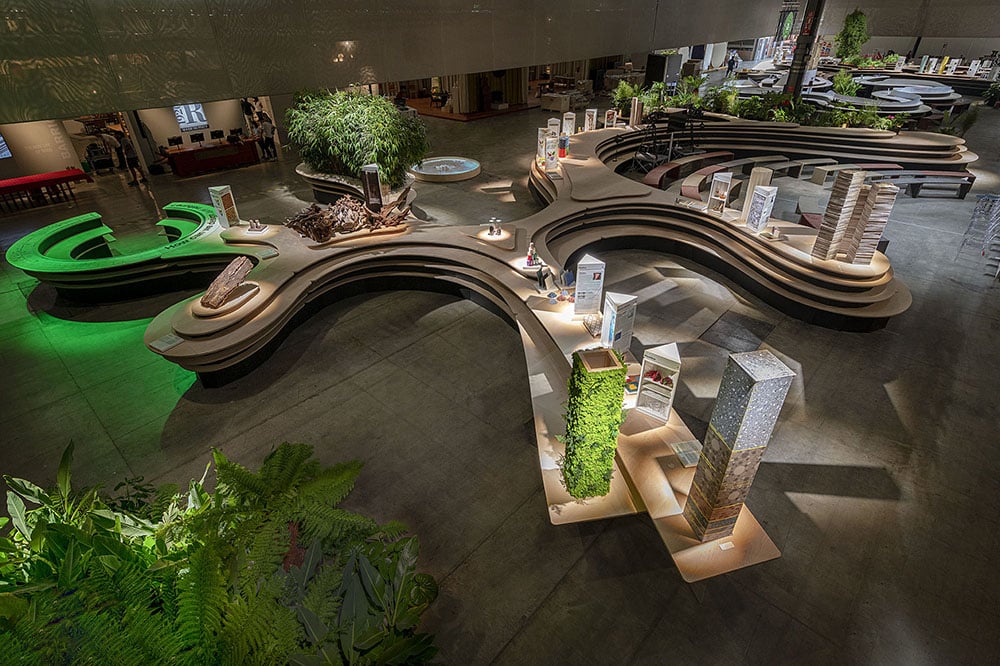
Would you like to comment on this article? Send your thoughts to: [email protected]
Latest
Products
Eight Building Products to Help You Push the Envelope
These solutions for walls, openings, and cladding are each best-in-class in some way—offering environmental benefits, aesthetic choices, and design possibilities like never before.
Viewpoints
3 Sustainability News Updates for Q3 2024
Policy initiatives are gathering momentum as the federal government and building sector organizations align their expertise under the umbrella of the Inflation Reduction Act.
Products
The Anthros Chair Goes Beyond Ergonomics
A brand-new task chair comes out of decades-long evidence-based research into wheelchair design and the human body.



